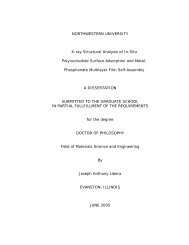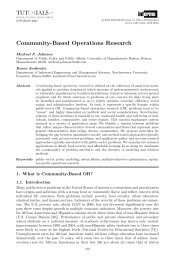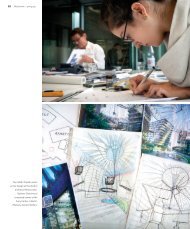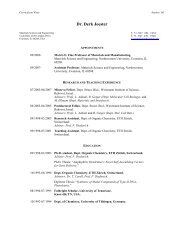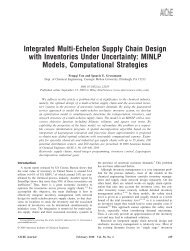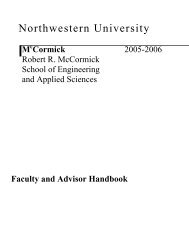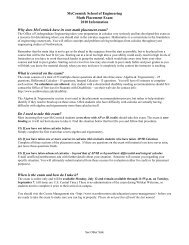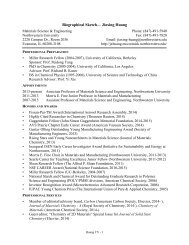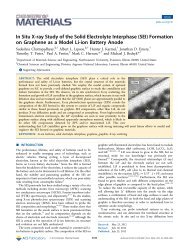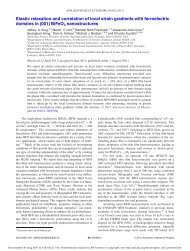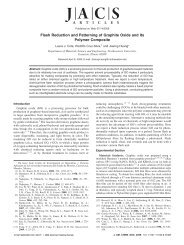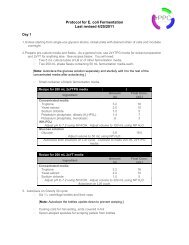Graphene oxide sheets, the chemical exfoliation ... - Jiaxing Huang
Graphene oxide sheets, the chemical exfoliation ... - Jiaxing Huang
Graphene oxide sheets, the chemical exfoliation ... - Jiaxing Huang
Create successful ePaper yourself
Turn your PDF publications into a flip-book with our unique Google optimized e-Paper software.
<strong>Graphene</strong> <strong>oxide</strong> <strong>sheets</strong>, <strong>the</strong> <strong>chemical</strong> <strong>exfoliation</strong> product of graphite powders andprecursor for <strong>the</strong> bulk production of graphene based materials, are found to beamphiphilic, and can act as surfactant to disperse insoluble materials or emulsifyorganic solvents (shown in left panel).
Pure Appl. Chem., Vol. 83, No. 1, pp. 95–110, 2011.doi:10.1351/PAC-CON-10-10-25© 2010 IUPAC, Publication date (Web): 1 December 2010<strong>Graphene</strong> <strong>oxide</strong> as surfactant <strong>sheets</strong>*Laura J. Cote, Jaemyung Kim, Vincent C. Tung, Jiayan Luo,Franklin Kim, and <strong>Jiaxing</strong> <strong>Huang</strong> ‡Department of Materials Science and Engineering, Northwestern University,Evanston, IL 60208, USAAbstract: Graphite <strong>oxide</strong> sheet, now referred to as graphene <strong>oxide</strong> (GO), is <strong>the</strong> product of<strong>chemical</strong> oxidation and <strong>exfoliation</strong> of graphite powders that was first syn<strong>the</strong>sized over a centuryago. Interest in this old material has resurged in recent years, especially after <strong>the</strong> discoveryof graphene, as GO is considered a promising precursor for <strong>the</strong> bulk production ofgraphene-based materials. GO <strong>sheets</strong> are single atomic layers that can readily extend up totens of microns in lateral dimension. Therefore, <strong>the</strong>ir structure bridges <strong>the</strong> typical lengthscales of both chemistry and materials science. GO can be viewed as an unconventional typeof soft material as it carries <strong>the</strong> characteristics of polymers, colloids, membranes, and ashighlighted in this review, amphiphiles. GO has long been considered hydrophilic due to itsexcellent water dispersity, however, our recent work revealed that GO <strong>sheets</strong> are actuallyamphiphilic with an edge-to-center distribution of hydrophilic and hydrophobic domains.Thus, GO can adhere to interfaces and lower interfacial energy, acting as surfactant. This newproperty insight helps to better understand GO’s solution properties which can inspire novelmaterial assembly and processing methods such as for fabricating thin films with controllablemicrostructures and separating GO <strong>sheets</strong> of different sizes. In addition, GO can be used asa surfactant sheet to emulsify organic solvents with water and disperse insoluble materialssuch as graphite and carbon nanotubes (CNTs) in water, which opens up opportunities forcreating functional hybrid materials of graphene and o<strong>the</strong>r π-conjugated systems.Keywords: amphiphiles; graphene <strong>oxide</strong>; interfaces; Langmuir–Blodgett technique; monolayers;surfactants.INTRODUCTIONAccording to <strong>the</strong> IUPAC Gold Book, graphene is a single carbon layer of <strong>the</strong> graphite structure analogousto a polycyclic aromatic hydrocarbon of quasi-infinite size [1]. It is a two-dimensional crystal consistingof a single atomic layer of sp 2 -hybridized carbon atoms (Fig. 1a). In 2004, it was isolated bymechanical <strong>exfoliation</strong> from graphite crystal and visualized under an optical microscope by AndreGeim and Konstantin Novoselov [2]. This has triggered <strong>the</strong> explosive growth of interest in this newmaterial across many disciplines, which has led to <strong>the</strong> discovery of many extraordinary properties [3].For example, graphene was found to have high optical transparency of 97.7 %, high electron mobilityof up to 200 000 cm 2 V –1 s –1 , high <strong>the</strong>rmal conductivity of up to 5000 Wm –1 K –1 , high nominal surfacearea of 2630 m 2 /g, and high breaking strength of 42 N/m. Therefore, many exciting applications*Pure Appl. Chem. 83, 1–252 (2011). A collection of invited, peer-reviewed articles by former winners of <strong>the</strong> IUPAC Prize forYoung Chemists, in celebration of <strong>the</strong> International Year of Chemistry 2011.‡ Corresponding author: E-mail: <strong>Jiaxing</strong>-huang@northwestern.edu95
96L. J. COTE et al.Fig. 1 Chemical structural models of graphene-based <strong>sheets</strong>. (a) <strong>Graphene</strong> consists of a single atomic layer ofsp 2 -hybridized carbon atoms which stack toge<strong>the</strong>r to form graphite (below). (b) GO consists of a graphene sheetderivitized by phenyl ep<strong>oxide</strong> and hydroxyl groups on <strong>the</strong> basal plane and carboxylic acid groups on <strong>the</strong> edges. Theedge –COOH groups can ionize resulting in an electrostatic repulsion between <strong>the</strong> <strong>sheets</strong>, allowing single layers toform an aqueous colloidal dispersion (below). (c) Chemically modified graphene (r-GO), although more defectivethan graphene, has a partially restored π-conjugated network in its basal plane, resulting in a darker color indispersion (below).have been envisioned and demonstrated. Geim and Novoselov’s groundbreaking discovery and experimentson graphene were recognized with <strong>the</strong> 2010 Nobel Prize in Physics.Among <strong>the</strong> family of derivatized graphene <strong>sheets</strong>, graphite <strong>oxide</strong> <strong>sheets</strong>, now called graphene<strong>oxide</strong> (GO), have actually been made for over a century [4,5]. They are typically syn<strong>the</strong>sized by reactinggraphite powders (Fig. 1a) with strong oxidizing agents such as KMnO 4in concentrated sulfuricacid. After oxidation, <strong>the</strong> graphene <strong>sheets</strong> are derivatized by carboxylic acid at <strong>the</strong> edges and phenolhydroxyl and ep<strong>oxide</strong> groups mainly at <strong>the</strong> basal plane (Fig. 1b) [6,7]. Therefore, <strong>the</strong> <strong>sheets</strong> can readilybe exfoliated to form a stable, light-brown-colored, single-layer suspension in water. This severefunctionalization of <strong>the</strong> conjugated network renders GO <strong>sheets</strong> insulating. However, conductivity maybe partially restored through reduction by <strong>chemical</strong> [8,9], <strong>the</strong>rmal [10,11], photo<strong>the</strong>rmal [12,13], andphoto <strong>chemical</strong> [14] treatments, producing <strong>chemical</strong>ly modified graphene <strong>sheets</strong> (a.k.a., reduced GO,r-GO) (Fig. 1c). This oxidization-<strong>exfoliation</strong>-reduction cycle effectively makes <strong>the</strong> insoluble graphitepowders processible in water, rendering many ways of using <strong>the</strong> conducting r-GO products. Although<strong>the</strong> resulting graphene product or r-GO is more defective and thus less conductive than pristinegraphene, <strong>the</strong> ease of syn<strong>the</strong>sizing GO and its solution processability has made it a very attractive precursorfor graphene-based materials and devices, especially in large-scale production [15–17].As shown in <strong>the</strong> three-dimensional structural model (Fig. 2a), a GO sheet is characterized by twoabruptly different length scales. The thickness is of typical molecular dimensions, measured to be about1 nm by atomic force microscopy (AFM) (Fig. 2b) [9,18]. But its lateral dimensions are of commoncolloidal particles, ranging from nanometers up to hundreds of microns. Therefore, GO <strong>sheets</strong> can becharacterized as ei<strong>the</strong>r molecules or particles, depending on which length scale/dimension is of greaterinterest. This molecule-particle duality should naturally make GO a particularly interesting system for© 2010, IUPAC Pure Appl. Chem., Vol. 83, No. 1, pp. 95–110, 2011
New insight into an old material 97Fig. 2 Molecule-particle duality of GO. (a) Three-dimensional structural model and (b) an AFM image of GO<strong>sheets</strong> depicting two abruptly different length scales: The apparent thickness of <strong>the</strong> sheet is about 1 nm, a typicallength scale of molecules, while its lateral dimension is of a length scale of common colloidal particles, rangingfrom nanometers to microns.both chemists and material scientists. In this review, we would like to highlight an alternative perspectiveof GO <strong>sheets</strong> that views it as an unconventional soft material [19,20], such as an amphiphile, andpresent a few discoveries motivated by this fundamental scientific curiosity.GO AS A NOVEL TWO-DIMENSIONAL AMPHIPHILEFundamental hypo<strong>the</strong>sisSince GO can easily disperse in water due to <strong>the</strong> ionizable edge –COOH groups, it has long beenthought of as hydrophilic [16,21–24]. However, a closer look at its structure reveals that it may actuallybe amphiphilic. Although <strong>the</strong> edges of GO are hydrophilic (Fig. 3a, orange), its basal plane containsmany polyaromatic islands of unoxidized graphene nanodomains (Fig. 3a, dark green). Thesehydrophobic, π-conjugated patches have recently been visualized directly by aberration corrected transmissionelectron microscopy (TEM) (Fig. 3b) [25]. Amphiphilic molecules contain both hydrophilicand hydrophobic regions, which are typically arranged in a linear, head-to-tail fashion. Such moleculesare characterized by <strong>the</strong>ir ability to stabilize interfaces, or act as surfactants, for example, to form emulsionsof oil and water or as dispersing agents to solubilize hydrophobic materials in water [26]. With<strong>the</strong> two-dimensional geometry of a GO sheet, many fundamental scientific questions arise about its surfactantbehavior, including: Would GO act as a molecular or colloidal surfactant to stabilize interfaces?How will parameters such as size and degrees of functionalization affect <strong>the</strong> sheet’shydrophilic–hydrophobic balance and <strong>the</strong>refore interfacial activity? Would GO’s edge-to-center configurationbring new surfactant functionalities? To answer <strong>the</strong>se questions, we will first need to studyGO’s interfacial activities.© 2010, IUPAC Pure Appl. Chem., Vol. 83, No. 1, pp. 95–110, 2011
98L. J. COTE et al.Fig. 3 GO as a surfactant sheet. (a) Structural model of GO depicting (orange) hydrophilic, ionizable edges and(dark green) hydrophobic, unoxidized graphitic nanopatches on <strong>the</strong> basal plane. (b) An aberration-corrected TEMimage showing <strong>the</strong> nanographene islands (dark green) within <strong>the</strong> basal plane of a GO sheet (adapted from [25],with permission from Wiley-VCH).Interfacial activity of GOMolecular amphiphiles are compounds that can adhere to interfaces [26]. If GO is amphiphilic, it shouldalso be surface active. Therefore, for an aqueous GO dispersion, GO <strong>sheets</strong> would adhere to <strong>the</strong> surfaceof water. Due to <strong>the</strong> large lateral dimension of GO, <strong>the</strong>ir presence at <strong>the</strong> air–water interface could bedirectly detected by Brewster angle microscopy (BAM). BAM is a surface-selective imaging techniquein which p-polarized light is incident on <strong>the</strong> water surface at <strong>the</strong> Brewster angle, <strong>the</strong> angle at which noreflection is allowed (Fig. 4b, top). When a surface monolayer is introduced, <strong>the</strong> surface refractive indexchanges and thus allows reflection from that region (Fig. 4b, lower) [27]. However, initial BAM imagingof a freshly prepared GO dispersion revealed little material on <strong>the</strong> surface. This can be attributed toa slow diffusion process resulting from <strong>the</strong> sheet’s large “molecular” mass. The journey to <strong>the</strong> air–waterinterface can be sped up by a flotation process, in which <strong>the</strong> surface active <strong>sheets</strong> adhere to rising gasbubbles and become trapped upon reaching <strong>the</strong> water surface (Fig. 4a). This was achieved with bubblingair or nitrogen through GO dispersion [28], alternatively commercial carbonated water can beused as a convenient in situ CO 2source. This can be done by simply dispersing GO in carbonated waterand subsequently adding boiling stones to release <strong>the</strong> dissolved gas. Indeed, flotation greatly enrichesGO at <strong>the</strong> water surface, appearing as bright spots against a dark background in <strong>the</strong> BAM image(Fig. 4c) [29].Fig. 4 Interfacial activity of GO. (a) GO can be enriched at water surface by flotation, appearing as white lightscatteringspots in <strong>the</strong> (b,c) BAM images. (d) GO is also active at <strong>the</strong> oil–water interface, as it can stabilizePickering emulsions of toluene in water (adapted from [29], with permission from ACS Publications).© 2010, IUPAC Pure Appl. Chem., Vol. 83, No. 1, pp. 95–110, 2011
New insight into an old material 99With <strong>the</strong>ir colloidal particle nature, GO <strong>sheets</strong> were also found to be capable of stabilizingoil–water interfaces to form <strong>the</strong> particle-stabilized Pickering emulsions [30]. As shown in Fig. 4d, gentleshaking of a toluene/GO water biphasic mixture results in large toluene droplets in water (Fig. 4d).These large droplets can remain kinetically stable for many months since GO <strong>sheets</strong> are now trapped at<strong>the</strong> oil–water interfaces [29]. Drop formation was found to occur more readily with aromatic solvents,like toluene and benzene, than with nonaromatic solvents, such as chloroform and hexane, indicatingπ−π interactions between <strong>the</strong> solvent and GO’s basal plane contribute to emulsion stability. As witho<strong>the</strong>r particle-stabilized emulsions, <strong>the</strong> droplet size was found to depend on colloidal concentration,with droplet size increasing as concentration decreases.Tunable amphiphilicity of GO <strong>sheets</strong>Being a sheet-like surfactant, GO’s amphiphilicity originates from <strong>the</strong> hydrophilic edges and hydro -phobic groups in its basal plane. For example, like ionic molecular surfactants, its amphiphilicity wouldvary with <strong>the</strong> degree of ionization of <strong>the</strong> edge –COOH groups, or <strong>the</strong> pH of <strong>the</strong> dispersion (Fig. 5a).Higher pH values would result in increased edge charges and <strong>the</strong>refore increased hydrophilicity of <strong>the</strong>sheet. GO’s edge-to-center arrangement of hydrophilic and hydrophobic groups suggests that sizeshould be a tuning parameter, too. It would be expected that smaller <strong>sheets</strong>, with a higher edge-to-arearatio, are more hydrophilic (Fig. 5b). Lastly, <strong>the</strong> size of hydrophobic nanographene regions on <strong>the</strong> basalplane of <strong>the</strong> GO sheet could be tuned by different degrees of reduction, or removal of oxygen functionalities(Fig. 5c) from <strong>the</strong> <strong>sheets</strong> [25]. An initial verification of <strong>the</strong>se hypo<strong>the</strong>ses can be made bystudying <strong>the</strong> effects of pH, size, and degree of reduction on <strong>the</strong> charge density and <strong>the</strong>reforehydrophilicity of GO. As shown in <strong>the</strong> zeta potential measurements (Fig. 5d), <strong>the</strong> charge density of GO<strong>sheets</strong> indeed decreases with decreasing pH values, increased sheet sizes, and increased degree ofreduction.Fig. 5 Amphiphilicity of GO is dependent on pH, sheet size, and degree of reduction as shown schematically in a,b, and c, respectively. (d) Zeta potential measurements show <strong>the</strong> charge density (i.e., hydrophilicity) of GOincreases with higher pH, smaller size (from regular micron-sized GO to nano-GO with diameter
100L. J. COTE et al.IMPACTS AND APPLICATIONSTwo-dimensional assembly of GO <strong>sheets</strong> on air–water interfaceAmphiphilicity is a fundamental solution property of materials. The new insight that GO is amphiphilicshould lead to a better understanding of <strong>the</strong> processing and assembly of GO <strong>sheets</strong>. GO can be solutionprocessedto form thin films by many techniques such as spin coating, drop casting, spraying, and dipcoating, etc. [15,17]. However, precise control over film thickness (i.e., number of layers) is difficult in<strong>the</strong>se techniques. Since GO is a surfactant, we can now take advantage of its surface activity and employ<strong>the</strong> classical molecular assembly methods, such as <strong>the</strong> Langmuir–Blodgett (LB) technique [31] to createmonolayers. In <strong>the</strong> classical LB technique, a surfactant monolayer is spread on <strong>the</strong> water surface andconfined between two movable barriers (Fig. 6a) [31]. As <strong>the</strong> barriers are closed, <strong>the</strong> surface density ofmolecules increases, leading to an increase in surface pressure, or reduction in surface tension that canbe continuously monitored by a tensiometer. The floating monolayers can <strong>the</strong>n be transferred to a solidsupport by vertical dip-coating. This technique has also been used to prepare monolayers of polymersand nanomaterials [32]. The two-dimensional water surface should serve as an ideal platform to assembleGO <strong>sheets</strong>. First, <strong>the</strong> interface is geometrically similar to GO, making it ideal to accommodate <strong>the</strong>flat <strong>sheets</strong>. Second, <strong>the</strong> soft, fluidic “substrate” should allow free movement of GO <strong>sheets</strong> upon manipulation.Third, water surface tension can help to keep <strong>the</strong> soft <strong>sheets</strong> flat, free from wrinkling or crumpling.Fig. 6 LB assembly of GO <strong>sheets</strong>. (a) With an LB trough, <strong>the</strong> surface density of GO <strong>sheets</strong> can be continuouslymanipulated by <strong>the</strong> barriers, and <strong>the</strong> surface pressure can be monitored by <strong>the</strong> tensiometer. Monolayers can betransferred to a solid substrate by dip-coating. (b) Surface pressure-area iso<strong>the</strong>rm of a GO monolayer showing acontinuously increasing surface pressure with decreasing area. (c–f) SEM images of monolayers collected from <strong>the</strong>corresponding regions in <strong>the</strong> iso<strong>the</strong>rm plot, showing continuously tunable surface coverage from (c) isolated flat<strong>sheets</strong>, (d) close-packed <strong>sheets</strong>, (e) overpacked <strong>sheets</strong> with folded edges to (f) overpacked <strong>sheets</strong> interlocked wi<strong>the</strong>ach o<strong>the</strong>r (adapted from [18], with permission from ACS Publications).Though typical spreading solvents are volatile and water-immiscible (e.g., chloroform, toluene),<strong>the</strong>se solvents do not disperse GO well [22]. Since GO is amphiphilic, it can be spread from alcoholsthat are even miscible with water, such as methanol [18]. When methanol droplets are gently droppedon water surface, it can first spread rapidly on <strong>the</strong> surface before mixing with water. In this way, <strong>the</strong> GO© 2010, IUPAC Pure Appl. Chem., Vol. 83, No. 1, pp. 95–110, 2011
New insight into an old material 101surfactant <strong>sheets</strong> can be effectively trapped at <strong>the</strong> air–water interface. The density of <strong>sheets</strong> can <strong>the</strong>n becontinuously tuned by moving <strong>the</strong> barriers. Upon compression, <strong>the</strong> monolayer exhibits a gradualincrease in surface pressure, as shown in <strong>the</strong> surface-pressure–area iso<strong>the</strong>rm plot (Fig. 6b). Films collectedby dip-coating along <strong>the</strong> compression curve were imaged by scanning electron microscopy(SEM) and showed four distinct packing behaviors. At <strong>the</strong> initial stage where <strong>the</strong> surface pressure isnear zero, <strong>the</strong> collected film consists of dilute, well-isolated flat <strong>sheets</strong> (Fig. 6c). As compression continues,a gradual increase in surface pressure begins to occur and <strong>the</strong> <strong>sheets</strong> start to close pack into abroken tile mosaic pattern over <strong>the</strong> entire surface (Fig. 6d). Upon fur<strong>the</strong>r compression, <strong>the</strong> soft <strong>sheets</strong>are forced to fold and wrinkle at <strong>the</strong>ir touching points in order to accommodate <strong>the</strong> increased pressure(Fig. 6e). This is in stark contrast to traditional molecular or colloidal monolayers which would collapseinto double layers resulting in a constant or decreasing surface pressure when compressed beyond <strong>the</strong>close-packed regime [33]. Even fur<strong>the</strong>r compression resulted in interlocked <strong>sheets</strong> with nearly completesurface coverage (Fig. 6f). The LB assembly produces flat GO thin films with uniform and continuouslytunable coverage, thus avoiding <strong>the</strong> uncontrollable wrinkles, overlaps, and voids in films fabricated byo<strong>the</strong>r techniques [15].Establishing structure–property relationship of r-GO monolayersThe monolayer shown in Fig. 6f has continuous and dense surface coverage. Upon reduction, it can turninto a conductive r-GO thin film. The properties of <strong>the</strong> resulting monolayer depend not only on <strong>the</strong> qualityof <strong>the</strong> individual <strong>sheets</strong> but also on how <strong>the</strong>y are assembled, which generates thin film microstructuresthat ultimately determine <strong>the</strong> film properties. Therefore, LB monolayers can be used as a modelsystem to investigate such microstructure–property relationships of solution-processed graphene-basedthin films. For example, wrinkles and overlaps are <strong>the</strong> two fundamental morphologies between flexible,interacting <strong>sheets</strong> that are usually convoluted in solution-processed GO thin films. If <strong>the</strong>se two types offeatures can be individually produced, we will be able to deconvolute how <strong>the</strong>se two basic micro -structures affect <strong>the</strong> electrical and optical properties of <strong>the</strong> final thin films.The surfactant-like properties of GO <strong>sheets</strong> suggest that one could potentially control how <strong>the</strong>yassemble at <strong>the</strong> air–water interface by tuning <strong>the</strong>ir amphiphilicity. Since <strong>the</strong> dissociation of edge–COOH groups is pH-dependent, <strong>the</strong> edge-to-edge interaction between GO <strong>sheets</strong> should also bepH-dependent [29]. This can be conveniently studied by adjusting <strong>the</strong> pH values of <strong>the</strong> water subphaseduring LB assembly. As shown in Figs. 7a,b, in situ BAM images reveal a clear change in GO packingon <strong>the</strong> water surface when <strong>the</strong> subphase pH is increased from acidic (pH 5.5) to basic (pH 10) levels[34]. On an acidic subphase, <strong>the</strong> initial monolayer has many islands of aggregated GO pieces (Fig. 7a),which are forced to arrange toge<strong>the</strong>r as <strong>the</strong> monolayer is fur<strong>the</strong>r compressed. When <strong>the</strong> subphase pH israised, <strong>the</strong>se islands disappear and <strong>the</strong> monolayer appears more uniform as GO <strong>sheets</strong> experiencegreater electro static repulsion (Fig. 7b). This change in aggregation state is accompanied by a drasticchange in <strong>the</strong> final surface pressure for compressed films, with a decrease typically from around 25mN/m in acidic subphase to a few mN/m in basic subphase. The large surface pressure drop indicatesa change in <strong>the</strong> microstructure of <strong>the</strong> monolayer, of which <strong>the</strong> interacting GO <strong>sheets</strong> may adopt a lessstrainedconfiguration.To investigate this, we collected monolayers in a highly compressed state from both acidic andbasic conditions to achieve high surface coverage. The samples are thus termed “acidic” and “basic”monolayers, respectively. Three microscopy techniques were used, namely, fluorescence quenchingmicroscopy (FQM) [35,36], SEM [18,36], and AFM to image <strong>the</strong> samples at length scales from millimeterdown to submicron. Large-area overview images collected by FQM (Figs. 7c,d) show comparablecoverage for both monolayers. However, parallel wrinkles are seen in <strong>the</strong> acidic monolayer asdepicted by <strong>the</strong> darker lines. The wrinkles are perpendicular to <strong>the</strong> direction of compression, indicating<strong>the</strong> entire monolayer buckled as one under compression. A more detailed view by SEM (Fig. 7e) revealsmany smaller wrinkles on <strong>the</strong> individual <strong>sheets</strong>. Such wrinkles typically occur near <strong>the</strong> edges of <strong>the</strong> GO© 2010, IUPAC Pure Appl. Chem., Vol. 83, No. 1, pp. 95–110, 2011
102L. J. COTE et al.Fig. 7 pH-dependent LB assembly of GO <strong>sheets</strong> observed by (a,b) BAM, (c,d) FQM, (e,f) SEM, and (g,h) AFM.At mild compressions, (a) <strong>sheets</strong> in <strong>the</strong> acidic monolayer form islands, while (b) in basic monolayer <strong>the</strong> <strong>sheets</strong>disperse more evenly. In <strong>the</strong> fully compressed state, wrinkles (c,e,g) and overlaps (d,f,h) are <strong>the</strong> dominatingmicrostructures in acidic and basic monolayers, respectively (adapted from [34], with permission from The RoyalSociety of Chemistry).© 2010, IUPAC Pure Appl. Chem., Vol. 83, No. 1, pp. 95–110, 2011
New insight into an old material 103sheet and are aligned to <strong>the</strong> contact lines of <strong>the</strong> interacting <strong>sheets</strong>, suggesting that <strong>the</strong>y are also bucklingstructures developed under in-plane compressive stress. AFM images (Fig. 7g) on individual wrinkledsites show that <strong>the</strong>y are typically more than 3 nm high and often reach 5–10 nm, effectively creatingmany 5–10-layer islands in <strong>the</strong> 1-nm-thick monolayer. In contrast, few wrinkles are seen in <strong>the</strong> basicmonolayers, whose microstructures are dominated by partial overlaps between neighboring <strong>sheets</strong>(Figs. 7d,f,h). The different packing behaviors are attributed to <strong>the</strong> pH-dependent hydrophilicity of GO<strong>sheets</strong>. GO <strong>sheets</strong> are more hydrophilic and wettable by water in basic conditions. Therefore, <strong>the</strong>y couldacquire a water lubrication layer, allowing <strong>the</strong>m to slide on each o<strong>the</strong>r, thus avoiding compressing eacho<strong>the</strong>r under compression. Overlapping also helps to reduce electro static repulsion between <strong>the</strong> chargededges of GO <strong>sheets</strong>. Under acidic conditions, <strong>the</strong> <strong>sheets</strong> are more hydrophobic and would be forced tosqueeze each o<strong>the</strong>r upon compression. Hydrogen bonding between <strong>the</strong> protonated edge carboxylic acidgroups and water surface tension may also prevent <strong>the</strong> <strong>sheets</strong> from sliding, forcing wrinkles to form duringcompression. Indeed, <strong>the</strong> wrinkled microstructures require higher surface pressure to maintain comparedwith <strong>the</strong> overlapped state, accounting for <strong>the</strong> above-mentioned drop in surface pressure when <strong>the</strong>subphase is tuned from acidic to basic conditions.Wrinkles and overlaps are common features in GO and graphene thin films. pH-dependent LBassembly can now offer model systems to deconvolute <strong>the</strong> effects of <strong>the</strong>se two types of micro structureson thin film properties, thus establishing a well-defined structure–property relationship [34]. As aproof of concept, we examined <strong>the</strong> effect of wrinkles and overlaps on <strong>the</strong> film’s sheet resistance andoptical transmission, <strong>the</strong> two most important performance parameters for transparent conductor thinfilms [37–41]. The sheet resistance of <strong>the</strong> r-GO monolayers, which were <strong>the</strong>rmally reduced at 500 °Cin Ar was measured between patterned gold electrodes with a narrow width of 0.25 mm and widewidth of 2.5 mm (Fig. 8a). The distribution of sheet resistance values measured at different spots on<strong>the</strong> film directly reflects <strong>the</strong> uniformity of coverage of <strong>the</strong> r-GO film. Uniform coverage should resultin consistent sheet resistance measurements, insensitive to electrode separation. O<strong>the</strong>rwise, <strong>the</strong> apparentvalues would scatter, especially with narrower electrode gaps. Sheet resistance values measured on<strong>the</strong> acidic, wrinkled monolayer (Fig. 8a, solid and hollow squares) have wide distributions, especiallyfor those measured with a narrow gap width (solid black squares), which scatter nearly two orders ofmagnitude. Conversely, values measured on <strong>the</strong> basic, overlapped monolayer (Fig. 8a, solid and opencircles) are much more consistent, regardless of electrode separation. FQM images of <strong>the</strong> thin filmsreveal that <strong>the</strong> wider distributions in wrinkled films are indeed due to less uniform coverage. This isconsistent with <strong>the</strong> BAM observations over a large area (Figs. 7a,b). Overall, <strong>the</strong> sheet resistance valuesfor acidic monolayers were only slightly higher but are more scattered than those of <strong>the</strong> basicmonolayers.These morphological features also affect <strong>the</strong> optical properties of <strong>the</strong> thin films. As shown in <strong>the</strong>AFM images (Figs. 8b,c), <strong>the</strong> wrinkled sites are much rougher than <strong>the</strong> overlapped ones. Therefore,<strong>the</strong>y can scatter light strongly, causing higher optical loss, thus decreasing <strong>the</strong> transparency of <strong>the</strong>monolayer. For example, <strong>the</strong> average percent transmission of <strong>the</strong> r-GO monolayers shown in Fig. 8 withwrinkles and overlaps was measured to be 94.1 and 96.1 %, respectively. This effect can be directlyimaged with a dark field optical microscope. As shown schematically in Figs. 8 d,e, in dark field imagingmode, light is incident on <strong>the</strong> sample at an oblique angle, such that only light scattered by <strong>the</strong> samplecan enter <strong>the</strong> front lens to form an image. The bright wrinkles can be clearly seen against <strong>the</strong> blackbackground (Fig. 8d), while <strong>the</strong> overlaps are essentially featureless. An aggregation of GO was shownin Fig. 8e only to focus <strong>the</strong> camera for <strong>the</strong> overlapped sample.The greater roughness of wrinkled r-GO film is also a disadvantage for organic thin film deviceapplications since <strong>the</strong>se pointy sites have higher probability to generate short circuit. Although <strong>the</strong>structure–property relationship described here was established with LB assembly of tiled GO pieces,<strong>the</strong> knowledge gained here should be useful for graphene films made by o<strong>the</strong>r methods. For example,graphene thin films made by <strong>chemical</strong> vapor deposition also start from isolated small domains, which© 2010, IUPAC Pure Appl. Chem., Vol. 83, No. 1, pp. 95–110, 2011
104L. J. COTE et al.Fig. 8 Wrinkles and overlaps: Structure–property relationship of r-GO monolayers. (a) Sheet resistance of <strong>the</strong>“wrinkled” r-GO monolayer (black squares) scatter greatly, indicating a lower film uniformity compared to that of<strong>the</strong> “overlapped” monolayer (red circles). Inset shows samples with gold electrodes of wide (2.5 mm) and narrow(0.25 mm) separations. (b,c) Three-dimensional view and line scan over <strong>the</strong> black line of AFM images showingmuch greater surface roughness of <strong>the</strong> wrinkled films compared with that of <strong>the</strong> overlapped film. (d,e) Dark fieldoptical microscopy images of wrinkled and overlapped samples, respectively. Wrinkles can be directly imaged (d)due to strong scattering, which causes higher optical loss of <strong>the</strong> monolayer. The overlapped monolayer isessentially featureless, suggesting much weaker optical scattering (adapted from [34], with permission from TheRoyal Society of Chemistry).grow larger and merge to achieve complete coverage of <strong>the</strong> substrate. Therefore, wrinkles and overlapsare also common features between <strong>the</strong> neighboring domains [42].© 2010, IUPAC Pure Appl. Chem., Vol. 83, No. 1, pp. 95–110, 2011
New insight into an old material 105Size separation of GODuring <strong>the</strong> syn<strong>the</strong>sis and processing of GO, <strong>the</strong> graphene <strong>sheets</strong> in <strong>the</strong> graphite particles are not onlyderivatized with oxygen-containing groups but also torn up into smaller pieces. As a result, <strong>the</strong> lateralsizes of <strong>the</strong> as-syn<strong>the</strong>sized GO <strong>sheets</strong> are usually very polydisperse, ranging from a few nanometers totens of micrometers, which may even vary from syn<strong>the</strong>sis to syn<strong>the</strong>sis. Based on <strong>the</strong>ir size-dependentamphiphilicity (Fig. 5b), new size separation techniques can be envisioned for GO. To test this, wemixed small <strong>sheets</strong> (5 μm) (Fig. 9a). This stock dispersion was spread onto <strong>the</strong> water surface in an LB trough (Fig. 9b).Samples were collected by dip-coating from <strong>the</strong> surface between <strong>the</strong> LB trough’s barriers, (Fig. 9c) andfrom <strong>the</strong> subphase outside <strong>the</strong> barriers (Fig. 9d). SEM images of <strong>the</strong> collected samples (Figs. 9c,d)clearly show a spontaneous size separation on <strong>the</strong> water surface. Large, less hydrophilic <strong>sheets</strong> can floaton <strong>the</strong> water surface while small, more hydrophilic <strong>sheets</strong> sink into <strong>the</strong> subphase. Therefore, <strong>the</strong> watersurface itself, without any features, can be used as a size-separation filter for GO <strong>sheets</strong> [29]!Fig. 9 Size separation of GO using <strong>the</strong> water surface as a filter membrane. (a) SEM image of GO <strong>sheets</strong> drop castfrom a dispersion containing both large (>5 μm) and small (
106L. J. COTE et al.Fig. 10 Size separation of GO <strong>sheets</strong> by emulsion extraction. GO’s size-dependent amphiphilicity is reflected in<strong>the</strong>ir emulsifying capability. As organic solvent (e.g., toluene) is added to GO dispersion to form emulsions (b), itextracts a portion of GO <strong>sheets</strong> from water, which are found to be mainly large <strong>sheets</strong> (>5 μm) as shown in <strong>the</strong>SEM image (a). Sequential emulsion extraction steps (b) would eventually deplete <strong>the</strong> large <strong>sheets</strong>, leaving <strong>the</strong>small <strong>sheets</strong> (5 μm). As<strong>the</strong> large <strong>sheets</strong> are continually removed in sequential extraction steps, <strong>the</strong> final portion of GO <strong>sheets</strong>left in water are much smaller ones (
New insight into an old material 107Fig. 11 GO acts as a surfactant to disperse insoluble materials in water. (a) Graphite powder and (d) CNTs arestabilized by a GO dispersion after sonication (left vials). In contrast, sonication does not disperse <strong>the</strong> materials inpure water (right vials). (c) Sonication of graphite in GO dispersion result in orders of magnitude size reductioncompared with (b) sonication in water as shown in <strong>the</strong> SEM images. (e) Sonication of CNTs in water cannot break<strong>the</strong> entangled bundles, while (f) sonication of CNTs in a GO dispersion disentangles <strong>the</strong> tubes. (f, inset) AFMimage shows that <strong>the</strong> CNTs are adhered to <strong>the</strong> GO surfactant <strong>sheets</strong> (adapted from [29], with permission from ACSPublications).be capable of dispersing o<strong>the</strong>r π-conjugated materials such as organic semiconductors and conductingpolymers.All-carbon compositesCNTs and graphene-based <strong>sheets</strong> have long been touted as promising materials for energy storage suchas in ultracapacitors due to <strong>the</strong>ir high electrical conductivity and surface area [47]. However, when usedindividually, both CNTs and graphene are prone to aggregation that will greatly limit <strong>the</strong>ir accessiblesurface area, which prevents <strong>the</strong> full realization of <strong>the</strong>ir high specific capacitance. This problem can besolved by co-assembling <strong>the</strong>se two geometries—<strong>sheets</strong> and tubes—to form CNTs-intercalated graphenestacks. Typically, <strong>the</strong> assembling strategies involve functionalizing CNT and/or graphene or r-GO<strong>sheets</strong> with dispersing agents [48,49] before mixing, which could introduce hard-to-remove impuritiesinto <strong>the</strong> final composites. Direct mixing was also achieved using highly unstable and highly toxic solventssuch as anhydrous hydrazine [50]. The new insight of GO’s amphiphilicity provides an immediatesolution since CNT-intercalated graphene films can now be easily made by sonicating unfunctionalizedCNTs in GO water, followed by <strong>the</strong>rmal or <strong>chemical</strong> reduction. As shown in Fig 12, <strong>the</strong> CNTsenveloped in between adjacent GO layers serve as both spacer to prevent restacking of <strong>the</strong> <strong>sheets</strong>, andas additional electrical conduction paths to improve <strong>the</strong> overall conductivity. The CNTs/GO hybrid canbe transformed to a conductive, all-carbon composite using ei<strong>the</strong>r <strong>the</strong>rmal or <strong>chemical</strong> reduction. Notethat <strong>the</strong> reduction of GO does not generate any hard-to-remove byproduct, thus enabling good car-© 2010, IUPAC Pure Appl. Chem., Vol. 83, No. 1, pp. 95–110, 2011
108L. J. COTE et al.Fig. 12 An all-carbon composite of CNTs/r-GO with enhanced electro<strong>chemical</strong> double-layer ultracapacitorperformance. (a) High-resolution cross-sectional SEM images of CNTs/r-GO (left) and r-GO (right) films. Scalebars = 500 nm. (b) Specific capacitance of CNTs/r-GO and r-GO electrodes under different scan rate. Note thatCNTs/r-GO composite displays higher specific capacitance and more stable power delivery at faster scan rate upto 500 mV/s.bon–carbon interconnect in <strong>the</strong> composite. Thermal and <strong>chemical</strong> reduction also lead to gas evolutionfrom GO, ultimately forming slightly expanded structures, in which <strong>the</strong> horizontal CNTs are nowstretched along <strong>the</strong> normal direction to <strong>the</strong> <strong>sheets</strong>, forming pillars to support <strong>the</strong> hybrid structure asshown in <strong>the</strong> cross-sectional SEM images (Fig. 12a, left). The resulting all-carbon hybrid was used aselectrode material for electro<strong>chemical</strong> double-layer ultracapacitors. Cyclic voltammetry measurements(Fig. 12b) show that after incorporating CNTs, <strong>the</strong> specific capacitance of r-GO film increase from 100to 175 F/g at a scan rate of 40 mV/s due to more accessible surface area by <strong>the</strong> electrolyte. Meanwhile,<strong>the</strong> shape of <strong>the</strong> cyclic voltammetry curves of <strong>the</strong> hybrid is more rectangular than that of <strong>the</strong> r-GO, and<strong>the</strong> specific capacitance of <strong>the</strong> hybrid is also more stable as <strong>the</strong> voltage scan rate changes due to higherinternal conductance of <strong>the</strong> electrode material allowing more efficient charge propagation. As shown inFig 12b, when <strong>the</strong> scan rate increases from 40, 100, 200, to 500 mV/s, <strong>the</strong> specific capacitance ofCNTs/r-GO only decreased by 2–5 %, while for r-GO electrode, it decreased by 10 %. Using GO as asurfactant eliminates <strong>the</strong> need for expensive and laborious material preparation methods. It will open up<strong>the</strong> possibility of preparing many o<strong>the</strong>r all-carbon or carbon-rich materials.CONCLUSIONSDespite being considered hydrophilic for <strong>the</strong> past century, GO is a unique two-dimensional amphiphilethat can adhere to gas–water, liquid–water, and solid–water interfaces and lower interfacial energy [29].Its amphiphilicity is tunable by solution pH values, sheet size, and degree of reduction. This new insight© 2010, IUPAC Pure Appl. Chem., Vol. 83, No. 1, pp. 95–110, 2011
New insight into an old material 109allows better understanding of <strong>the</strong> solution property of GO, which is helpful for designing better assemblyand processing techniques for graphene thin films [18,28]. Well-defined microstructure–propertyrelationship of graphene monolayers can be established by tuning <strong>the</strong> assembly of <strong>the</strong>se surfactant<strong>sheets</strong> [34]. Size-dependent amphiphilicity inspires novel size separation methods such as water surfacefiltration and emulsion extraction. GO <strong>sheets</strong> can be used as dispersing agents to create colloidal dispersionsof insoluble materials, especially π-conjugated aromatic systems such as conjugated polymers,CNTs, and graphite, thus enabling <strong>the</strong>ir solution processability. As a novel surfactant, GO offers a fewadvantages. For example, as a colloidal surfactant with large dimension, <strong>the</strong>y can be easily recovered(e.g., by filtration). They can be readily converted to <strong>chemical</strong>ly modified graphene, rendering <strong>the</strong> finalcomplex of surfactant-dispersed phase electrically conductive. When GO is used to disperse carbonbasedmaterials, it allows for <strong>the</strong> creation of clean carbon–carbon junctions that would o<strong>the</strong>rwise becontaminated by common molecular surfactants or degraded by covalent functionalization, whichshould facilitate charge transport across <strong>the</strong> interfaces. Since surfactants are routinely used in <strong>chemical</strong>and material industries as well as in our daily life, perhaps what this new surfactant system can do isonly limited by our imagination.ACKNOWLEDGMENTSThis work was primarily supported by <strong>the</strong> National Science Foundation (CAREER DMR 0955612).Additional supports were provided by <strong>the</strong> Initiative for Sustainability and Energy at Northwestern(ISEN), <strong>the</strong> Northwestern Nanoscale Science and Engineering Center (NSF EEC 0647560), <strong>the</strong>Northwestern Materials Research Science and Engineering Center (NSF DMR-0520513) and <strong>the</strong> SonyCorporation. L.J.C. is a NSF graduate research fellow. We thank Y. Wa, Prof. K. R. Shull, Z. Zhang,J. H. <strong>Huang</strong>, Prof. C. W. Chu, and Prof. C. Sun for collaboration in some of <strong>the</strong> works presented in thisreview.REFERENCES1. E. Fitzer, K. H. Kochling, H. P. Boehm, H. Marsh. Pure Appl. Chem. 67, 473 (1995).2. K. S. Novoselov, A. K. Geim, S. V. Morozov, D. Jiang, Y. Zhang, S. V. Dubonos, I. V. Grigorieva,A. A. Firsov. Science 306, 666 (2004).3. A. K. Geim, K. S. Novoselov. Nat. Mater. 6, 183 (2007).4. B. C. Brodie. Philos. Trans. R. Soc. London 149, 249 (1859).5. W. S. Hummers, R. E. Offeman. J. Am. Chem. Soc. 80, 1339 (1958).6. A. Lerf, H. Y. He, M. Forster, J. Klinowski. J. Phys. Chem. B 102, 4477 (1998).7. W. Gao, L. B. Alemany, L. Ci, P. M. Ajayan. Nat. Chem. 1, 403 (2009).8. W. H. Dobelle, M. Beer. J. Cell Biol. 39, 733 (1968).9. S. Stankovich, D. A. Dikin, R. D. Piner, K. A. Kohlhaas, A. Kleinhammes, Y. Jia, Y. Wu, S. T.Nguyen, R. S. Ruoff. Carbon 45, 1558 (2007).10. R. C. Croft. Quarterly Rev. 14, 1 (1960).11. H. C. Schniepp, J. L. Li, M. J. McAllister, H. Sai, M. Herrera-Alonso, D. H. Adamson, R. K.Prud’homme, R. Car, D. A. Saville, I. A. Aksay. J. Phys. Chem. B 110, 8535 (2006).12. L. J. Cote, R. Cruz-Silva, J. <strong>Huang</strong>. J. Am. Chem. Soc. 131, 11027 (2009).13. S. Gilje, S. Dubin, A. Badakhshan, J. Farrar, S. A. Danczyk, R. B. Kaner. Adv. Mater. 22, 419(2010).14. G. Williams, B. Seger, P. V. Kamat. ACS Nano 2, 1487 (2008).15. M. J. Allen, V. C. Tung, R. B. Kaner. Chem. Rev. 110, 132 (2010).16. S. Park, R. S. Ruoff. Nat. Nanotechnol. 4, 217 (2009).17. O. C. Compton, S. T. Nguyen. Small 6, 711 (2010).18. L. J. Cote, F. Kim, J. <strong>Huang</strong>. J. Am. Chem. Soc. 131, 1043 (2009).© 2010, IUPAC Pure Appl. Chem., Vol. 83, No. 1, pp. 95–110, 2011
110L. J. COTE et al.19. I. W. Hamley. Introduction to Soft Matter: Polymers, Colloids, Amphiphiles and Liquid Crystals,John Wiley, New York (2007).20. R. A. L. Jones. Soft Condensed Matter, Oxford University Press (2002).21. D. A. Dikin, S. Stankovich, E. J. Zimney, R. D. Piner, G. H. B. Dommett, G. Evmenenko, S. T.Nguyen, R. S. Ruoff. Nature 448, 457 (2007).22. S. Gilje, S. Han, M. Wang, K. L. Wang, R. B. Kaner. Nano Lett. 7, 3394 (2007).23. D. Li, R. B. Kaner. Science 320, 1170 (2008).24. D. Li, M. B. Muller, S. Gilje, R. B. Kaner, G. G. Wallace. Nat. Nanotechnol. 3, 101 (2008).25. K. Erickson, R. Erni, Z. Lee, N. Alem, W. Gannett, A. Zettl. Adv. Mater. 22, 4467 (2010).26. D. Myers. Surfactant Science and Technology, Wiley-Interscience, Hoboken, NJ (2006).27. M. M. Lipp, K. Y. C. Lee, J. A. Zasadzinski, A. J. Waring. Rev. Sci. Instrum. 68, 2574 (1997).28. F. Kim, L. J. Cote, J. <strong>Huang</strong>. Adv. Mater. 22, 1954 (2010).29. J. Kim, L. J. Cote, F. Kim, W. Yuan, K. R. Shull, J. <strong>Huang</strong>. J. Am. Chem. Soc. 132, 8180 (2010).30. S. U. Pickering. J. Chem. Soc. 91, 2001 (1907).31. M. C. Petty. Langmuir-Blodgett Films: An Introduction, Cambridge University Press, Cambridge,UK (1996).32. A. R. Tao, J. X. <strong>Huang</strong>, P. D. Yang. Acc. Chem. Res. 41, 1662 (2008).33. C. Ybert, W. X. Lu, G. Moller, C. M. Knobler. J. Phys. Chem. B 106, 2004 (2002).34. L. J. Cote, J. Kim, Z. Zhang, C. Sun, J. <strong>Huang</strong>. Soft Matter (2010). doi: 10.1039/C1030SM00667J35. J. Kim, L. J. Cote, F. Kim, J. <strong>Huang</strong>. J. Am. Chem. Soc. 132, 260 (2010).36. J. Kim, F. Kim, J. <strong>Huang</strong>. Materials Today 13, 28 (2010).37. H. c. A. Becerril, J. Mao, Z. Liu, R. M. Stoltenberg, Z. Bao, Y. Chen. ACS Nano 2, 463 (2008).38. S. De, J. N. Coleman. ACS Nano 4, 2713 (2010).39. G. Eda, G. Fanchini, M. Chhowalla. Nat. Nanotechnol. 3, 270 (2008).40. Q. Su, S. P. Pang, V. Alijani, C. Li, X. L. Feng, K. Mullen. Adv. Mater. 21, 3191 (2009).41. X. Wang, L. Zhi, K. Mullen. Nano Lett. 8, 323 (2007).42. X. S. Li, W. W. Cai, L. Colombo, R. S. Ruoff. Nano Lett. 9, 4268 (2009).43. N. Grossiord, J. Loos, O. Regev, C. E. Koning. Chem. Mater. 18, 1089 (2006).44. L. Vaisman, H. D. Wagner, G. Marom. Adv. Colloid Interface Sci. 128–130, 37 (2006).45. R. Bandyopadhyaya, E. Nativ-Roth, O. Regev, R. Yerushalmi-Rozen. Nano Lett. 2, 25 (2001).46. M. Zheng, A. Jagota, E. D. Semke, B. A. Diner, R. S. McLean, S. R. Lustig, R. E. Richardson,N. G. Tassi. Nat. Mater. 2, 338 (2003).47. M. D. Stoller, S. Park, Y. Zhu, J. An, R. S. Ruoff. Nano Lett 8, 3498 (2008).48. D. S. Yu, L. M. Dai. J. Phys. Chem. Lett. 1, 467 (2010).49. Y. K. Kim, D. H. Min. Langmuir 25, 11302 (2009).50. V. C. Tung, L. M. Chen, M. J. Allen, J. K. Wassei, K. Nelson, R. B. Kaner, Y. Yang. Nano Lett.9, 1949 (2009).© 2010, IUPAC Pure Appl. Chem., Vol. 83, No. 1, pp. 95–110, 2011



